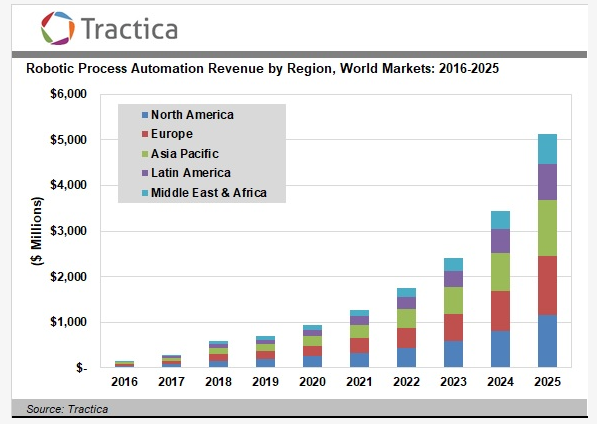If you are someone who’s been following digitech trends for the past few years, Robotics Process Automation (RPA) wouldn’t be an unfamiliar term. RPA is an emerging technology that can swiftly perform human intense, laborious activities. RPA, also termed as Software Bots, mimics a human worker in carrying out certain tasks within a process including interacting with an enterprise application, feed data into a data sheet etc. An RPA technology sits on top of an existing solution and automates rules-driven and repetitive tasks that need to be carried out across multiple systems or applications.
Swivel Chair Tasks
Swiveling in a chair could be fun if it doesn’t involve work. In many organizations, processes are still not automated. Employees literally swivel between applications or computers to perform the laborious task of manually extracting information from one application and then validating it and pasting it in another application.
What if the workload increases? Is increase in the labor force the only solution? Let’s see.
Demerits of Labor Workforce
Inaccurate Results: To err is human. Any manual intense labor is never 100% accurate
Increased Expenses: When the business process changes, hiring and training human workforce becomes expensive
Slower Process: Humans consume twice as more time to complete the task
Data Inconsistency: As the work gets passed on to a different set of people, the work pattern varies and the data originality is lost in the process
Decreased Productivity: A human can work an average of only 8 hours a day; even in that limited time period, handling multiple tasks is difficult
Scalability Issue: Humans don’t easily adapt to changes; they need to be trained to handle the system if it undergoes changes
The days of Swivel Chair Automation are numbered
Process optimization can be easily achieved by automating some tasks in a process. Assigning these tasks to humans is only a temporary solution as swiveling back and forth between systems as stated above is cumbersome and time-consuming. This is where RPA comes into picture. It occupies a small space alongside other digital tools. It can be easily deployed on any legacy system and carries out the laborious, mundane and repetitive tasks within fractions of seconds, improving the speed, efficiency, and freeing humans from swivel chair slowdown.
RPA implementation is now gaining momentum across various industries including:
- Human Resources & Administration
- Finance
- Healthcare
- Insurance
- Manufacturing & Retail
- Travel & Logistics
Benefits of RPA
RPA is very useful in organizations that have complex systems that interact together. Understanding the existing system, adapting to changes, manipulating data and triggering responses are the special features of RPA that distinguish it from the traditional IT automation.
Speed: According to a report by an MIT economist, a robot can perform the same amount of work that 5.6 people can perform, within a short span of time
Scalability: As the business grows, the RPA platform can be easily reconfigured to handle the changes
Reliability: Humans are error prone, not machines; RPA implementation with various organizations have proven 100% accuracy
Seamless Integration: RPA technology can be easily integrated with any legacy system
24/7 Digital Workforce: The automated process runs 24X7X365 unless changes are made in the system
Flexibility: Robots can be easily reconfigured if business priorities change
Free up Human Talent: When an automation process is in place to perform mundane repetitive tasks, the human workforce can focus on other challenging tasks
Cost Effective: A single technology is programmed to execute even complex tasks; avoiding additional resource allocation and training costs
Future of RPA
A Forrester report states that RPA market will reach $2.9 Billion by 2021. According to Statista, RPA industry will be worth $3.1 billion by 2019 and $4.9 billion by 2020. Researchers at Tractica forecasts that worldwide revenue in the sector will increase from $0.151 billion in 2016 to more than $5.1 billion in 2025.
Conclusion
Businesses are always on a hunt for a new solution that is more efficient and cost-effective. Robotics is one such solution that has taken a quantum leap in this technology thriving world. Any industry in any part of the world will benefit from this intelligent automation system. Robotic Process Automation has already transformed the way businesses operate in many industries by replacing Human Workforce with Digital Workforce. Let’s adopt this sophisticated innovation and optimize our business like never before.
- Empower Commerce with Oracle Retail Omnichannel Suite - February 20, 2019
- Top 9 necessary optimizations for your Ecommerce UX Audit – Part 3 - November 28, 2018
- Top 9 necessary optimizations for your Ecommerce UX Audit – Part 2 - October 29, 2018










Comments